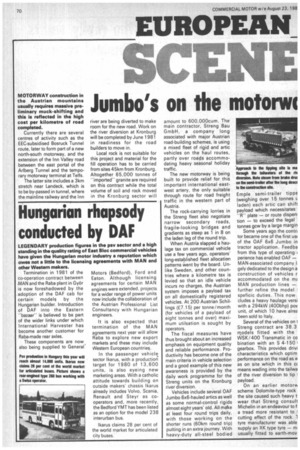Jumbo's on the motorm
Page 72

Page 73

If you've noticed an error in this article please click here to report it so we can fix it.
MOTORWAY construction in the Austrian mountains usually requires massive preliminary muck-shifting and this is reflected in the high cost per kilometre of road completed.
Currently there are several centres of activity such as the EEC-subsidised Bosruck Tunnel route, later to form part of a new north-south motorway, and the extension of the Inn Valley road between the east portal of the Arlberg Tunnel and the temporary motorway terminal at Telfs.
The latter site includes a 3km stretch near Landeck, which is to be by-passed in tunnel, where the mainline railway and the Inn river are being diverted to make room for the new road. Work on the river diversion at Kronburg will be completed by June 1981 in readiness for the road builders to move in.
Local rock is not suitable for this project and material for the fill operation has to be carried from sites 45km from Kronburg. Altogether 65,000 tonnes of "importedgranite are required on this contract while the total volume of soil and rock moved in the Kronburg sector will
amount to 600,000cum. The main contractor, Streng Bau GmbH, a company long associated with major Austrian road-building schemes, is using a mixed fleet of rigid and artic vehicles on the haul routes, partly over roads accommodating heavy seasonal holiday traffic.
The new motorway is being built to provide relief for this important international eastwest artery, the only suitable through route for road freight traffic in the western part of Austria.
The rock-carrying lorries in the Streng fleet also negotiate narrow secondary roads, fragile-looking bridges and gradients as steep as 1 in 8 on the laden leg of the round trip.
When Austria slapped a haulage tax on commercial vehicle use a few years ago, operators' long-established fleet allocation patterns Went by the board. Unlike Sweden, and other countries where a kilometre tax is levied so that an idle vehicle incurs no charges, the Austrian system imposes a payload tax on all domestically registered vehicles. At 200 Austrian Schillings (E7.15) per tonne/month (for vehicles of a payload of eight tonnes and over) maximum utilsation is sought by operators.
The fiscal measures have thus brought about an increased emphasis on equipment quality and reliable performance. Productivity has become one of the main criteria in vehicle selection and a good example of this new awareness is provided by the daily work programme for the Streng units on the Kronburg river diversion.
Vehicles include several OAF Jumbo 6x6-hauled artics as well as some normal-control rigids almost eight years' old. All malce at least four round trips daily, with those working on the shorter runs (60km round trip) putting in an extra journey. With heavy-duty all-steel bodied Emote semi-trailer tippe (weighing over 15 tonnes L laden) each artic can shift payload which necessitates "R" plate — or route dispen, tion to exceed the legal tonnes gcw by a large margin
Some years ago the contn tor became one of the first us, of the OAF 6x6 Jumbo in tractor application. Feedba from this type of operating perience has enabled OAF — MAN-associated company I gely dedicated to the design a construction of vehicles r accommodated on the rniMAN production lines — further refine the model speficic duties. This now cludes a heavy haulage versi with a 294kW (400bhp) pov unit, of which 10 have alree been sold to Italy.
Several of the vehicles on 1 Streng contract are 38.3 models fitted with the WSK /400 Transmatic in co bination with an S 4-150 gearbox. This provides drivi characteristics which optim performance on the road as vi as on site which in this means wading into the tailwa of the river diversion to tip payload.
On an earlier motorw scheme Dolomite-type rock the site caused such heavy t wear that Streng consult Michelin in an endeavour to f a tread more resistant to cutting effect of the rock. 1 tyre manufacturer was able supply an XK type tyre — rfr usually fitted to earth-mov ant — in a size suitable for J c k and trailer use. Streng :cordingly invested about 08,000 to fit most units in a 32-strong fleet.
Many of the Austrian-built )ping bodies have Edbro lgle ram tipping gear :hough pto's, pumps and draulic circuitry are by an'ter Continental manufacturer. int on the Kronburg site indes some huge US-built )bco dump trucks and Hough yloader shovels, but the most pressive feature of the rockoperation is the ability of the ics to reach all parts of the site thanks to the power/ 6x6 driveline combination and to place their payload exactly where required with the minimum employment of other plant.
The Kronburg sector of the new motorway is being financed by funds accruing from the tolls collected on the Brenner route. As with the introduction of the haulage tax there was considerable opposition to the relatively high cost of using the Brenner Motorway, especially when commercial traffic was prevented from using the old (tollfree) road.




















































































































